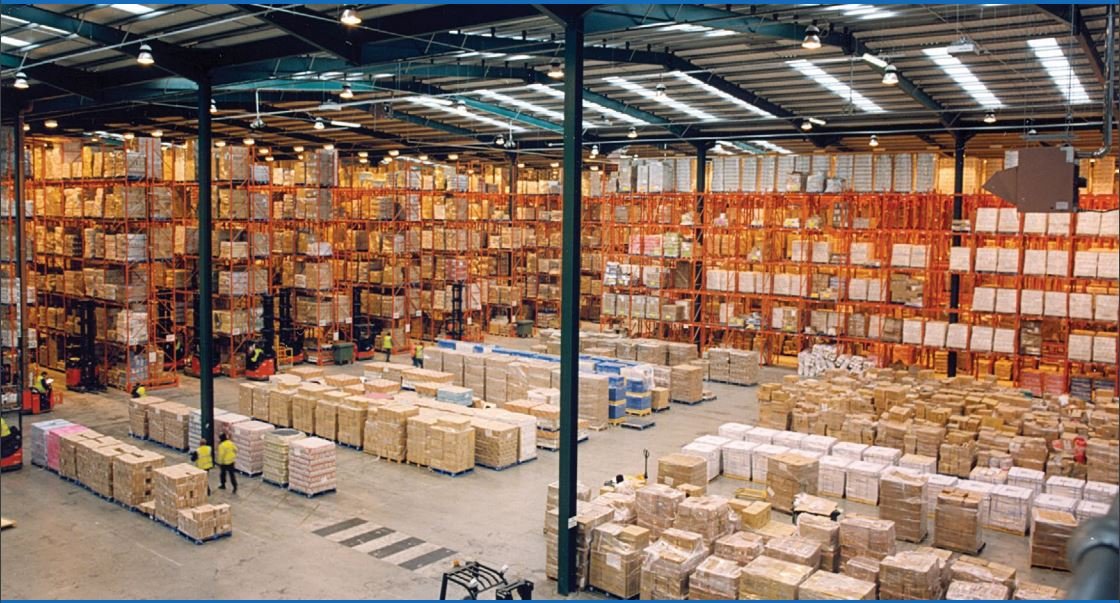
Thanks for downloading our e-book about warehouse productivity. As the title suggests, this guide is all about warehouse efficiency, how good design principles and management can help your business run smoother and more profitably and enable you to grow and expand.
In the chapters that follow we’re going to take a look at how you can analyse your current operation and see how you are performing, before going into practical ways for you to boost performance in your warehouse and beyond. The goal of each suggestion is to make your life easier by using sound principles and technologies to save you time and money.
We’ve broken this guide into short sections to keep the information as succinct and targeted as possible. This is above all things a practical guide – it isn’t a book about logistics theory. We appreciate that, as important as warehouses are, it is best when they perform their functions effectively, and you don’t have to think about them too much.
This is the end goal of warehouse productivity management: to establish a warehouse that integrates with the rest of your business and acts as a powerful asset for achieving your company goals.
As you’re reading this, we will assume that warehouse management is a key part of your business. We work with all sorts of clients, all of whom make use of a logistics supply chain. We’ve worked with a number of growing retailers, wholesalers, and e-commerce and mail order businesses. Our clients also include global distribution companies, hospitals, pharmaceutical companies, manufacturers, government departments and many family owned and SME businesses. Our customer base includes some large household names, such as House of Fraser, Screwfix, Unilever, Poundland and Scotts of Stow– but we also work with small companies who are developing and need to evolve their warehouse operations to cope with either growth or change in their businesses.

As Logistics Planning Consultants we specialise in everything to do with strategic supply chain management. This includes warehouse design and optimisation, but also extends to transport modelling, network design, resource planning, warehouse design, implementation, project management and much more. Our range of consultancy services is tailored to you to ad hoc support through to full project involvement to make your logistics more cost-effective.
As a business we have worked for clients in most business sectors for over 30 years, with LPC having been founded in 1984. Our principle directors have combined service in the company of more than 60 years, and we employ a highly-qualified team of consultants and logistics experts. As the worldwide economy changes and grows, so do the demands of supply chain management. Our role is to help our clients adapt to the demands of the global market and to use technology and logistical software proactively, to retain a competitive edge by thinking outside the box.
Technologies and methods have changed over the last 30 years and will no doubt continue to do so, but our goal remains the same; to provide expert solutions to all the logistical questions you face as a business.
Full details of all our services can be found on our website. If you have any questions while reading this guide, please don’t hesitate to get in touch with one of our team. You can call us on 01285 640038, or you can send us a direct message through our online contact form.
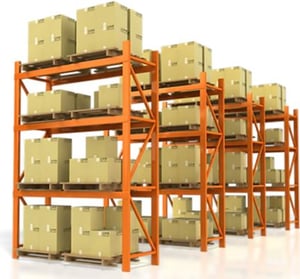
With this all said and introductions made, let’s get straight down to business and talk about YOUR warehouse. Specifically, is it fit for purpose and how do you know?
There isn’t any arcane secret to an efficient, well-run warehouse. Whatever logistic issues you may come up against, chances are that there are a number of different solutions you could try. Some of this will depend on your budget, on your existing logistics infrastructure and the preferences of your business.
Whatever your current setup, we can work with you to help you improve efficiency. Whether you have a single warehouse or a nationwide network, there are always improvements you can make without having to start from scratch. Sometimes, of course, it is time to move or expand, and we can advise you on this as well.
So we can illustrate the principles of good warehouse design, let’s assume for the moment that you intend to move to a new warehouse. . How do you go about designing it for growth, flexibility and productivity?
When advising clients on a new warehouse design we look at the following nine points; the same principles that we apply when advising a business on how to improve an established operation.
1) Understand Your Requirements: Begin with a firm understanding of what you want your warehouse to do. What does your business need from a warehouse? No two companies will give the same answer to this, so take a look at your product range, your throughput and the needs of your customers. This can be done in four steps.
2) Designing from the Inside-Out: Your greatest outlay when building your new warehouse will be the physical building itself, as well as any related mechanical material handling systems attached to it. Moreover, once erected, the fabric of the warehouse will be very difficult to change. When designing a new warehouse you are in a privileged position, as you have the luxury of creating the building to accommodate your processes, products and equipment, rather than simply making the best use of the space you already have. We call this designing from the inside out. Defining your requirements first, to
ensure optimum performance and then designing the warehouse envelope structure, enveloping the operational area.
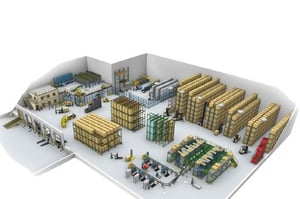
3) Standardise your Units: Depending on your industry, you may measure your storage/transportation units in terms of pallets, ISO freight containers or totes. For almost all organisations, managing your warehouse in terms of collective unit loads makes for a more effective use of space than measurement in individual items. When designing a warehouse, standardise the units you use to match your product profile, with as few variations as possible. This ensures you can use all your warehouse space in a flexible way. You should also make sure these are compatible with the industry standards prevalent in your market.
4) Make The Best Use Of Your Space: Physical space, not just floor area but also the cube, is the most valuable asset you have available in your warehouse, so design your area to be as cost-effective as possible. Designing from the inside-out, understand your products first when considering how to use your space. Analysis methods such as Pareto Analysis can categorise your product lines based on their storage requirements, throughput and handling needs. These can then suggest suitable space utilisation methods and stock rotation systems to make sure your storage and handling areas are well planned. Choosing the right equipment is also important. The majority of your warehouse space will be devoted to product storage and movement. You should therefore invest in versatile, appropiate equipment with a small space footprint and good productivity output.
5) Establish An Efficient Flow Process: When moving stock, plan for the quickest and most effective route between A and B. There are two main ways to do this, by using a Through Flow or U Flow layout. The choice you make depends on the layout of your stock, organised by product popularity or in sections of similar units (family groups). Your logistics process also influences it; for instance. how the stock is received, stacked, picked, packed and dispatched within the warehouse and the number of doors required. You also need to establish the most efficient means of carrying out this movement, with the idea that each handler or vehicle should travel the shortest possible distance to carry out their task. You don’t want your team to waste time and energy making inefficient journeys.
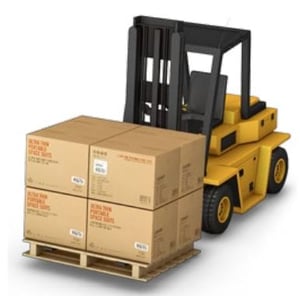
6) Design For Productivity: Each warehouse-using business will decide on a staffing level that suits its requirements. Some of our clients have highly automated their warehouses to minimise human involvement, while others retain large warehouse teams potentially to enable maximum flexibility. The
key here is always to maximise employee productivity, and this is something that can be quantified in advance and then measured against wage rate to
ensure a good ROI. Identify processes where changes can be made, such as order picking, and look for means by which time can be saved and labour costs reduced. When designing a new warehouse, you can establish your space with efficient processing in mind. For instance, you can minimise the length of your picking route, introduce staff incentives and bonuses to increase productivity, or implement IT systems that automate parts of the process. Revised KPIs should always be accompanied by appropriate training and incentives to keep your staff motivated.
7) Design Your Structure: Once you’ve established clear processes, stock control procedures and optimum staffing levels, you can design the physical structure of your warehouse to accommodate them. Following the principle of designing from the inside-out, the internal structures come first e.g. the grid of structural columns and roof clearance with the required operating height. What follows are the floor loadings, loading docks and internal structures, such as mezzanine floors, lighting levels and storage units. Finally, the peripheral elements of design, which extend to administrative offices, staff facilities, battery charging, fork truck park up, valued added activities etc.
8) Reduce Access Congestion: Designate your external areas so that supply and delivery vehicles can come and go unimpeded. The usual suspects that contribute to congestion and delays are your employee’s cars, pedestrian traffic, and stored empty pallets, cages and waste. When designing a new site, plan to keep your walkways and staff car park well away from your delivery area, it’s much safer, and assign specific places for waste and empty units. Pay attention to vehicle flows on the site, one way directional and no blind side reversing onto docks. Plan your space to accommodate future expansion, so that your area doesn’t become overdeveloped and congested.
9) Futureproof Your Warehouse: No business can claim to be resistant to change. Your market, your customers, your suppliers and the profile of your workforce will change over time. When designing your warehouse, establish dynamic processes and policies that can accommodate change and are resilient to developments in your business. The physical environment of your warehouse should reflect this. Our consultants can help you take an uncertain future into account when creating a responsive warehouse solution for your business.
10) Maximise Real Estate Value: You should also never forget that your warehouse is an important property asset, worth hundreds of thousands, if not millions of pounds in resale value. At some point, you may wish to sell your warehouse to another company or let. Your design should therefore have one eye on market value – how you can maximise the price you can demand from future owners. So the design may want to reflect institutional standards that provides flexibility for different types of users.
While the last chapter took you through the principles of good warehouse design for new facilities, this section is aimed at businesses who want to improve the performance of an existing warehouse. Fortunately, you don’t have to start from first principles every time. Here are ten ways you can optimise your logistics for a highperforming warehouse, regardless of what the economy is doing.
Most of your net worth as a business is tied up in the inventory you hold. There are costs associated with ownership, both in terms of maintaining your stock and in providing warehousing. Therefore, managing your inventory to reduce unnecessary holdings and ensuring you have space for the products that have demand, is a great way of improving cost effectiveness and wasting less space.
Reducing and centralising your stockpile opens the door to improving your warehouse infrastructure by streamlining your inventory, administrative, security and management processes.

Looking at the big picture, you will see there is a trade-off between savings in one department, versus increased costs in another. For instance, reducing the
number of warehouses will yield savings in terms of storage and handling, but will increase transport costs, whereas having a wider storage network will cost more in warehousing but will reduce transport expenses.
We delved into the world of planning software in the last section with our discussion of logistics route management. The good news is you can also use
software applications to help you manage your warehouse more effectively, saving money across a number of processes.
This chapter will review the benefits of investing in a Warehouse Management System (WMS) for your business:
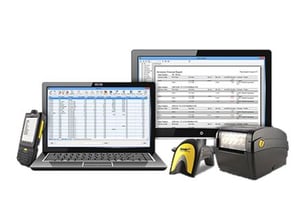
You have invested in a high-quality WMS and are keen to benefit from all its reporting functions. Which Key Performance Indicators (KPI’s) are the most useful ones to keep an eye on for businesses wanting to run an efficient operation? There are hundreds of different metrics that you can measure with a WMS, but for us these are the top five:
1) Inventory Cost: Your warehouse inventory represents a significant cost to the business, not merely in terms of the retail value of the products, but also in capital cost, risk, insurance, servicing costs and obsolescence. Taking these considerations into account gives you the carrying cost of your inventory, which is useful to quantify.
The figure is arrived at by the formula: Inventory carrying rate X Average inventory value = Carrying Cost (This metric is useful for helping you forecast demand and stock turnover)

2) Inventory Turnover (Stock Turns): Measuring your inventory turnover rate allows you to assess your ordering practice. Which product lines are in greater demand than others? Are some stocks approaching obsolescence? Your WMS will allow you to keep a handle on this in real-time, adjusting your inventory to maximise turnover. As a metric, inventory turnover defines the number of times a warehouse gets through its complete inventory in a year.
The formula is: Cost of sold goods / Average Inventory Cost= Inventory Turnover
You can measure your inventory turnover figure against competitors and industry averages to gauge your comparative performance and see where improvements can be made.
3) Inventory to Sales Ratio: Your business cash flow is largely dependent on the income received from sales versus the expenses of replenishing your inventory. This is your inventory to sales ratio and why it is important. Monitoring this figure - for instance if inventory levels rise while sales figures drop – can help you predict and prevent cash flow problems. More positively, it could also help you predict a spike in demand, allowing you to make sure you have enough stock to satisfy your customers.
Here is the formula if you wanted to take a DIY approach (Your WMS will do this for you) Inventory balance /calendar month sales = Inventory to Sales Ratio
4) UPT (Units per Transaction): By monitoring your average UPT you can assess the performance of your sales team over time, as well as changing trends within your market. For some businesses this figure is fairly stable, while for others it changes quite drastically at different times of the year. Understanding this figure provides useful information for sales and marketing teams, leading to new strategies to boost sales. It can also help you plan the best use of space when rationalising your warehouses or building new premises. UPT is calculated by a simple equation:
Units sold /Number of transactions = Units per Transaction
5) Returns rate: No one likes to think about returns, but they are an essential part of any cost analysis for warehouse operations. It is therefore one of the most important KPIs you can measure. A high rate of return is always a cause for concern that warrants further investigation. A WMS will log a cause of return next to each incident, so you can see how many returns are the result of damage, wrong shipment, and late deliveries, faulty products and so on. Understanding the cause of returns empowers you to take specific action to bring down your overall returns rate. Calculate your Rate of Return by:
Returned Units / Total Units Sold
Keeping track of these core KPIs and taking the appropriate remedial action can visibly improve warehouse performance within a short period of time. At every level of your operation, efficiencies can be made; costs reduced and customer service improved. Once you have established a well-designed and closely managed warehousing operation, monitoring performance ensures you keep on top of your game by making continual adjustments whenever they are required.
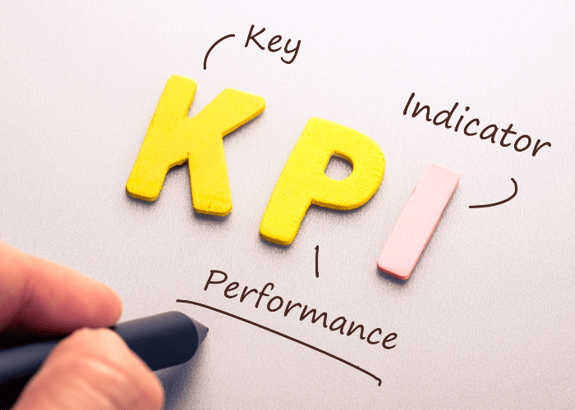
After reading through this guide you may be having a few thoughts, and maybe even some worries, about how your warehouse is performing. If so, that is no bad thing. Even the most efficient and well-run warehouse operations can benefit from a few changes here and there to tighten up the process. When you are ‘in the thick of things’ managing a busy warehouse operation, it is easy to develop blind spots. This happens in any line of work. For instance:
It is sometimes helpful to get an independent expert come in from the outside and offer a fresh opinion. This is why we are offering a FREE Warehouse Logistics HealthCheck.
One of our experienced logistics consultants will come to your distribution centre for a full day and help you analyse your systems, infrastructure and processes using some of the principles we’ve explained in this e-book. Then, if you’re interested in taking our services further, we can devise a practical plan
to improve the efficiency of your operation. This may involve implementing new WMS software, remapping your storage layout, taking a second look at your staffing levels, remodelling your product flows or even designing a new warehouse. Whatever is best for you, we are committed to working closely with you and your team at every step of the journey, to fully meet your requirements and complete the project on time and within budget.
To book your Free Logistics HealthCheck – a full day’s worth of free, no obligation consulting followed up with a report outlining how improvements in efficiencies can be made, please sign up using the following link on our website: http://blog.lpcinternational.co.uk/free-logistics-healthcheck
Many thanks again for reading this guide. We hope you found it useful and informative. If you would like to talk to one of our experts or find out more about our services, please get in touch by one of the following means. We look forward to speaking to you!
Website: www.lpcinternational.co.uk
Send us a message: Click Here
Call us: 01285 640038